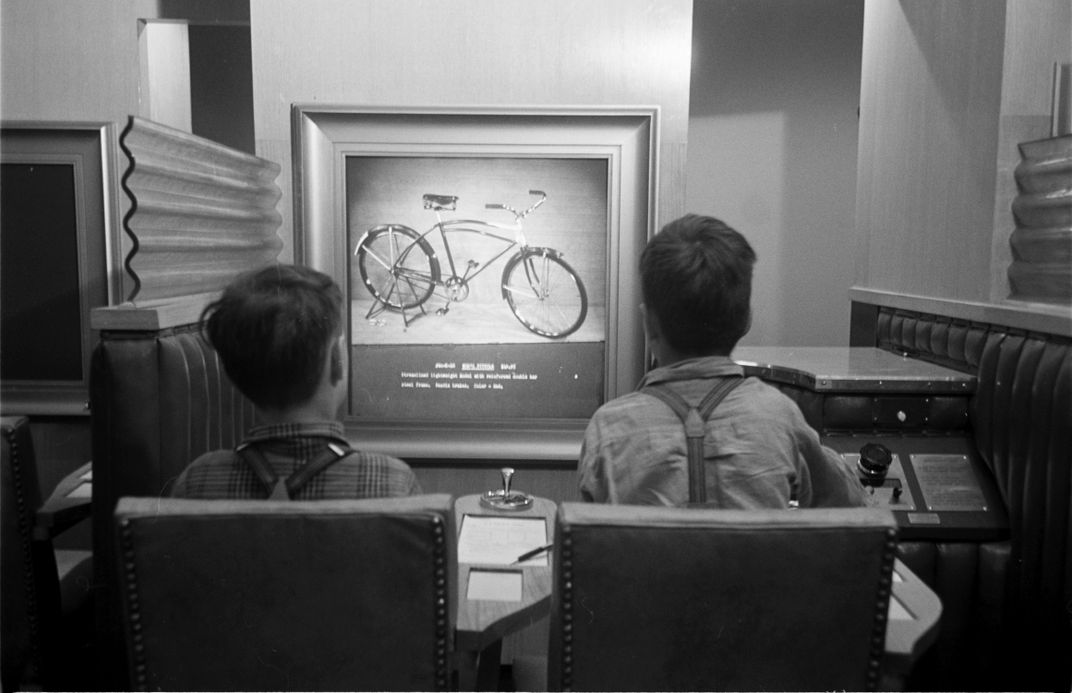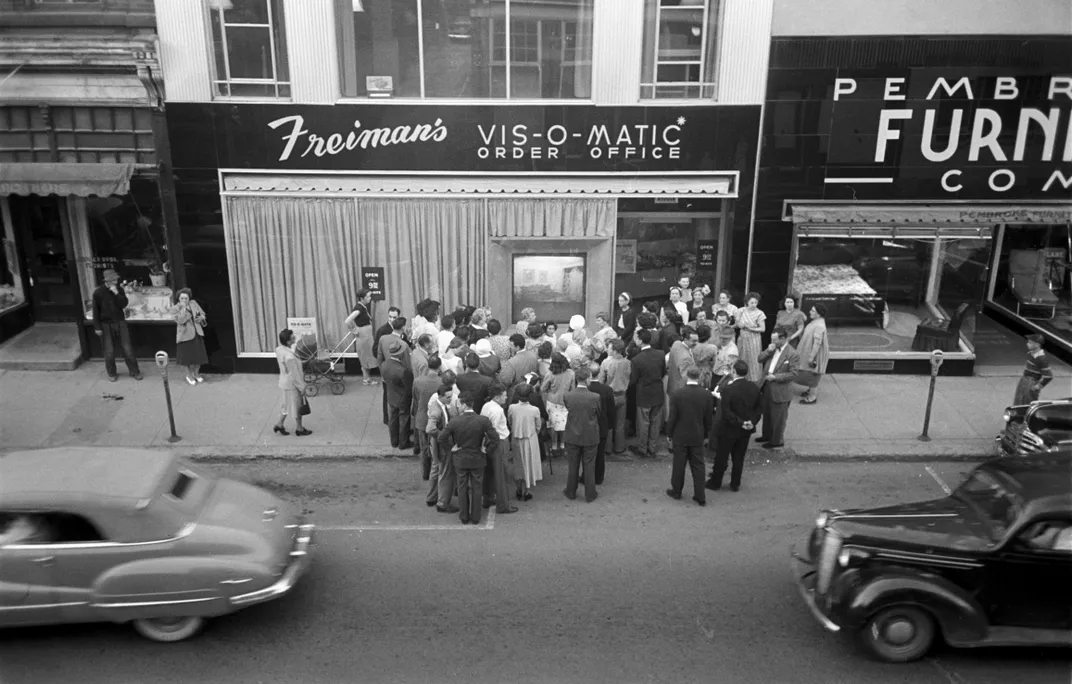‘Vis-O-Matic’ Was the 1950s Version of Online Shopping
A Canadian department store tried to revolutionize buying when it opened a shop with booths and screens for ordering merchandise
When the department store A.J. Freiman announced in May 1950 its plan to bring "push button" shopping to the small town of Pembroke, Canada, newspapers across North America were baffled. The New York-based Women's Wear Daily informed its readers that "no indication is given as to what precisely the project is, and inquiries at the Ottawa store elicit no further details for the time being." The only information the reporters received was a cryptic press release that noted A.J. Freiman’s pride in presenting "for the first time anywhere this great retail innovation." The new brand of store, the press release added, would be dubbed the "Vis-O-Matic."
A month later, when the project launched, A.J Freiman's innovation became clear. "Vis-O-Matic" was the Amazon Prime of its era: a store equipped with televisions where customers sat down, ordered products off the screen, and then headed home as the company shipped the purchases directly to them.
Lawrence Freiman, who ran the family business since 1939, had been kicking around the idea for five years, according to a June 1950 edition of the Canadian newspaper Globe and Mail, and he finally launched a trial version in Pembroke, just over 90 miles northwest of his company's base in Ottawa.
The setting was essential to Freiman. For a large, urban department store, the small-town market remained elusive. A.J. Freidman couldn't afford to ship its extensive catalog across Canada to a town that didn't have the population size to deliver large sales figures. But as postwar wages ballooned across North America, the market for consumer goods was growing, and A.J. Freidman also couldn't pass up a host of potential shoppers, even if they were geographically scattered. As Business Week put it in 1950: “What do you do when rising incomes turn thinly settled areas into good markets? Those are a couple of the problems that face more and more big city department store operators every day.”
So Lawrence Freiman devised a revolutionary solution: rather than ship its full backlist to Pembroke, it would open a visual store, one equipped with television screens that broadcast images of its products. That way, the A.J. Freiman inventory could stay in Ottawa, where the department store was based.
The Pembroke outpost, reported the Globe and Mail, was "a small air-conditioned shop on the main street, fitted with booths and screens on which color pictures of merchandise articles are to be flashed." Customers sat down in front of one of eight booths fitted with 27-square-inch color televisions. Built into each booth were three buttons: an "advance" button that toggled forward through the catalog, a "reverse" button that toggled back, and a knob that let customers jump past a large volume of slides—say, from item 50 to item 150. In all, 3,750 products were digitized and available for shipment to Pembroke.
When customers settled on a product, they wrote down their order on a notepad that, Women's Wear Daily reported, was actually integrated into the booth armrests for easy access. Customers handed the paper to one of four "sales counsellors" who used a teletype, a precursor to the fax, to send it back to Ottawa. Then, at least per the official pitch from A.J. Freiman, "the goods are delivered the next day by mail or express"—a shipping time that might make modern online stores seem rudimentary.
Freiman didn't create the Vis-O-Matic alone. In mid-June, Women's Wear Daily reported that A.J. Freiman had recruited Fred Waller—who in 1939 invented and later patented the curved, multi-projector movie screen known as the Cinerama—to develop the technology. Waller, under the umbrella of his television company Vitarama Corp, was apparently negotiating with Freiman "over distribution of Vis-O-Matic for the United States."
In that same article, Women's Wear Daily declared that Freiman and Waller had initiated a retail revolution: "It is the introduction of shopping through a completely visual process."
Freiman, too, seemed enthusiastic about the launch. On June 14, only a week after the Pembroke Vis-O-Matic store opened, he told the newspaper, "Our first experiences indicate there is no question but that we can sell anything by this method.” Women's clothing—especially dresses, sportswear and shoes—were the biggest seller on the Vis-O-Matic screens, with clothing for children following closely behind. Yet, according to Freiman, “Business has also been done at the Pembroke store on such items as major appliances, radios, linoleum."
The concept of purchasing from afar, however, was not entirely innovative. "I always point out that distance shopping is not new, even if digital shopping is," says Donica Belisle, a professor at the University of Regina in Canada who writes about the history of consumer culture. "Sears started to print catalogs in the 1880s and Canadian department stores quickly caught on, with Eaton’s mail order catalog going all over the country by the late 1890s."
But the Vis-O-Matic system may have felt like a step up from print shopping catalogs in part because it was so novel. "It debuted during the same time as televisions, and not everyone had a television in the 1950s," says Belisle. "It may have been more exciting than print catalogs." The Globe and Mail in 1950 described another advantage of the Vis-O-Matic over a print catalog: "It can adjust its prices quickly to changes in the market."
The idea did seem to gain steam. In November 11, 1950, the newspaper The Manitoba Ensign declared that “enquiries have come not only from Canada and the United States but from many overseas countries as well” asking how to purchase their own versions of the Vis-O-Matic. The Vis-O-Matic, the newspaper declared, was about to "go places" and would "replace [the] mail order catalogue." More than 20,000 people had visited the store in four months, and A.J. Freiman was planning to expand across rural Canada not only by building more Vis-O-Matic offices, but by wiring up the technology to trailers as well.
In another glowing early review, the magazine Popular Photography argued in March 1951, "The system could well revolutionize the mail-order business."
Still, Freiman was well aware that his store wouldn't be profitable in the short term. The cost of shipping individual orders the nearly 100 miles from Ottawa to Pembroke was far too massive to offset any profits unless customers throughout Canada were placing remote orders. He repeatedly clarified that the Pembroke store was an experiment, and "we shall continue to proceed cautiously." In a separate Women's Wear Daily article, Freiman said, "Quite frankly, it is not economic for one operation."
A perhaps telling inclusion in the Manitoba Ensign article was that "the only bar to its more rapid spread through Canada’s smaller towns is the lack of machines."
Yet although A.J. Freiman appeared to be profitable—in April 1951, Women's Wear Daily wrote that A.J. Freiman hit a "new sales peak" after its Vis-O-Matic launch—news coverage of the Pembroke store trailed off around that time, and, despite the early hype, no other location seems to have been opened. There do not appear to have been further reports on the Vis-O-Matic between 1951 and 1971, when A.J. Freiman was sold to retail giant Hudson's Bay, and most consumer culture historians aren't familiar with the innovation.
But even if its brand has been lost to time, the central idea of the Vis-O-Matic lives on today. Just as Lawrence Freiman dreamed, customers across the globe regularly sit down and order everything from appliances to apparel off of a catalog on a screen.
/https://tf-cmsv2-smithsonianmag-media.s3.amazonaws.com/filer/66/af/66af7c1f-efaf-44cd-830a-e6f654a66e4a/6_vis.jpg)

/https://tf-cmsv2-smithsonianmag-media.s3.amazonaws.com/filer/2c/41/2c41a942-d0d0-4e56-8d19-bfdafab3e4f0/7_vis.jpg)
/https://tf-cmsv2-smithsonianmag-media.s3.amazonaws.com/filer/69/f8/69f89b8c-2e29-44fd-8d6f-4a7999345a13/8_vis.jpg)

/https://tf-cmsv2-smithsonianmag-media.s3.amazonaws.com/filer/0a/68/0a6835a7-c2ab-4b9c-a3f5-8f46b5cb760d/11_vis.jpg)
/https://tf-cmsv2-smithsonianmag-media.s3.amazonaws.com/filer/23/c7/23c78d1c-d848-48a5-a28c-5dcb178e9b6c/vis-o-matic-2.jpg)
/https://tf-cmsv2-smithsonianmag-media.s3.amazonaws.com/filer/21/5c/215c32ba-f9f4-4ab7-85b2-c2fe7e3fff66/vis-o-matic-3.jpg)
/https://tf-cmsv2-smithsonianmag-media.s3.amazonaws.com/filer/b2/ba/b2baaa09-4bfb-4c08-a079-c00e4e669e4e/vis-o-matic-4.jpg)
/https://tf-cmsv2-smithsonianmag-media.s3.amazonaws.com/filer/ff/15/ff15f810-118e-409f-98c2-e78675439b15/vis-o-matic.jpg)